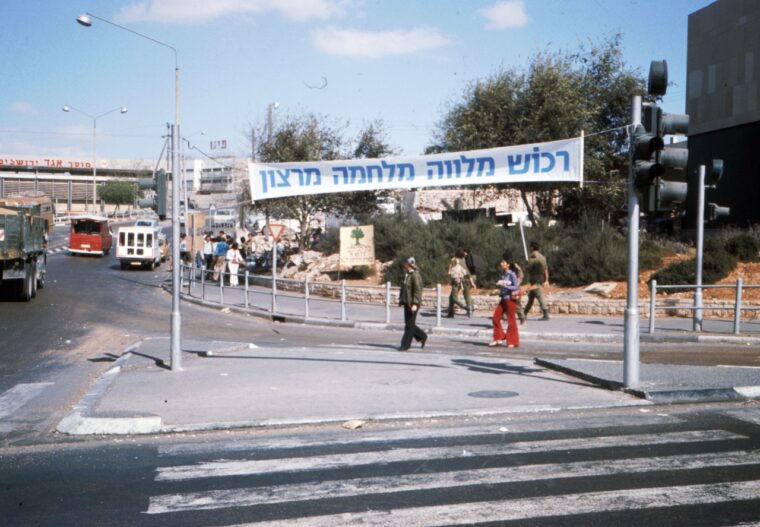From studlife.com
By Michael L Millenson
In mid-August 1973, I and a handful of other Washington University students began our Junior Year abroad program at Hebrew University in Jerusalem with two months of language classes (Ulpan). This preceded the regular academic year, set to start in mid-October after the Jewish holidays. Still, my Hebrew remained fairly rudimentary.
At that time, I lived in dorms in an out-of-the-way, working-class neighbourhood called Kiryat Yovel. For Yom Kippur, traditionally spent in fasting and prayer, I travelled to the main campus to attend services with friends. The dorms were close to the English-speaking Conservative movement’s seminary.
When I arrived in Israel, I began keeping a diary. Below is my lightly edited record of a traumatic period in Israel’s history that began with the outbreak of the Yom Kippur War on Oct. 6, 1973, and whose “social, political, economic and psychological effects,” in the words of Israeli political scientist Susan Hattis Rolef, are still being felt.
Saturday, Oct. 6, 1973. Yom Kippur
I leave services and go back to the dorms for a nap. At two o’clock in the afternoon, when I am half asleep, I hear the wailing sound of an air-raid siren. I sit up and listen. At 2:10, the siren wails again. There is running in the halls, and people are playing their radios very loudly. I check the location of my pants and resolve to put them on quickly. A while later, an “all-clear” sounds. I make a mental note to find out what the fuss was all about.

Courtesy of Michael Millenson
[Note: I had no clue that the country, including the radio, goes completely silent during Yom Kippur and that the sirens signalled a national emergency.]
When I get up at 4 p.m. and wander down the hall, I ask a group of American kids gathered around a radio whether anyone knows why the sirens sounded. They stare at me. Egypt and Syria have launched massive tank attacks along the Sinai and the Golan Heights, with heavy battles being fought. Doctors are being called up, and hospitals are being evacuated to prepare for the wounded. The bus drivers have been ordered back to provide transportation. Yoram, one of the madrichim (resident advisors) has already been called back to his unit.
Signs are up at the dorms telling us where shelters are. At 4:15 p.m., the radio is beeping, then broadcasting names every 15 minutes — code for different reserve units. The radio signal is weak, and Arab music from Jordan can be heard incongruously in the background. The sky has clouded over, and it has grown chilly.
Patti, a friend from WashU; Sondra, Patti’s friend from back home in Dallas; and I can’t understand the Hebrew anyway, so we head for shul. We are anxious, but we make wry jokes, having total confidence in the Israeli military. At 6:45 p.m., we walk back to the dorms in the dark. A barrier is up on the road, along with two parked trucks and an Army tent.
A blackout is in effect for the country. I go to a group gathered near the office, get a candle and matches from madricha Ruti. She informs me that we’re evacuating this dorm and moving up the hill to other dorms that have shelters, and to take food, a blanket, a flashlight, and a candle.
The rooms are fairly big, but hot — the blinds are all closed. Aaron Singer, the head of the One-Year Program, comes around to assure us that people will be here to guide us in the case of an emergency, and if the American Embassy says anything, we’ll be notified. I ask him how things are at Kiryat Yovel. He says he wants to go and find out and offers to take me. Delighted, I clear out.
We listen to the English news at 8:45 p.m. The Egyptians have beachheads on the east part of the Suez Canal, but they’ve been contained, Israel Broadcasting tells us. [Note: They were lying.] Singer translates Prime Minister Golda Meir’s speech to the nation: “There is no doubt of our victory,” she declares.
At Kiryat Yovel, some of the students have hitchhiked back from the (Conservative movement) youth hostel and other places. One panicked Canadian girl says the Western Wall was packed with people deep in prayer. The siren goes off — and they all start to scatter. The same thing happened in one of the Jerusalem neighbourhoods.
Two of the resident advisors have already gone to their units. Tokens for phone calls are in short supply; I give a couple to Israeli kids in the dorm — one in uniform already — who are trying to call their units.
At 11 p.m., a group of us listens to the Voice of America. The VOA plays a CBS News report from Tel Aviv, to the background of wailing air-raid sirens. We can imagine what our parents must be thinking.
Israel Broadcasting at midnight says the situation is contained at both Sinai and Golan. There are two thousand Syrian tanks in the Golan! VOA says heavy fighting is still going on.
Sunday, Oct. 7, 1973
“Students are urged to buy food tomorrow, but not too much,” says the notice posted in the dorms. Jerusalem housewives certainly heeded the first part of this advice.
By the time I get to the Supersol at 9:30 a.m., the battle has already been waging for two hours. All six lines are filled with people backed into the aisles. Many have shopping carts completely filled, despite periodic announcements that there is only food to buy for today. One man indignantly defends his three loaves of bread to the checker, who tells him to put some back. I leave. By 11:30 a.m. when I return, there is plenty of milk, and new vegetables have replaced the battle-weary ones earlier.
Everywhere, people gather around the radio, straining to hear. It is very frustrating during wartime to only be able to understand the general outlines of the broadcast.
We go to Ulpan this afternoon. Our teacher Shulamit is an officer in the Instruction Corps, so they were not called up. We learn a slew of new words — frontier, blackout, armoured unit, absorption of attack — which are immediately proving to be useful. At night, two middle-aged men with Hagah, the Civil Defence Command, are standing in the street in front of the dorms and calling up to those with unshaded lights shining from their rooms. Cars have appeared with their headlights painted over in blue.

Courtesy of Michael Millenson
The battles still appear serious. We expect a good number of casualties, given the lightly-manned posts on the borders. [Note: I had just turned 20. Israeli draftees manning those posts were 18-, 19-, and 20-year-olds.]
Monday, Oct. 8, 1973
Most of our class comes to Ulpan this morning, but there is no teacher. Buses are infrequent. An armoured personnel carrier rumbles up the street in downtown Jerusalem, not carrying troops at present, but ready. Windows on downtown stores are taped, following the orders of Hagah.
The war has a name: “the Yom Kippur War.”
Michael Millenson, BA 1975, was a humour columnist for Student Life before going on to become a Pulitzer Prize-nominated journalist at the Chicago Tribune, a healthcare consultant, a book author, and an adjunct faculty member at Northwestern University. To listen to the full narration, Millenson elaborates on the Take One podcast.
No comments:
Post a Comment